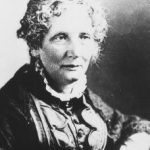More than fifteen years ago I walked from my office to a local elementary school once each week to read with a little first grade boy for half an hour to help increase his reading skills. That little boy is now a bright young man in college. When he found out that I was reading Uncle Tom’s Cabin by Harriet Beecher Stowe for the first time, my long-time friend Rob wrote, “Wait! Is it possible that I read a book before you? I had to read it in high school!”
 Yep, it’s true, Rob. Uncle Tom’s Cabin was not required reading at my high school in the early 1970’s. It has traveled in and out of favor throughout its sixteen-decade life. Stowe’s novel (the first runaway bestseller in American history) has been controversial from the day it was published in 1852. Abolitionists loved it, pro-slavery activists condemned it. It was praised at the time by Frederick Douglass and panned many years later by James Baldwin. It is credited with igniting a political furor among abolitionists that led to the creation of the Republican Party. President Lincoln, our first Republican president, is said to have greeted Ms. Stowe at the White House with, “Is this the little woman who made this great war?”
Yep, it’s true, Rob. Uncle Tom’s Cabin was not required reading at my high school in the early 1970’s. It has traveled in and out of favor throughout its sixteen-decade life. Stowe’s novel (the first runaway bestseller in American history) has been controversial from the day it was published in 1852. Abolitionists loved it, pro-slavery activists condemned it. It was praised at the time by Frederick Douglass and panned many years later by James Baldwin. It is credited with igniting a political furor among abolitionists that led to the creation of the Republican Party. President Lincoln, our first Republican president, is said to have greeted Ms. Stowe at the White House with, “Is this the little woman who made this great war?”
It remains controversial today. In one view (including mine) Uncle Tom is the strongest character in the book. He was steadfast in his faith and beliefs in the face of brutality and death. In another view he was spineless and would not stand up to tyranny when he had the opportunity. “Uncle Tom” has been a term of derision to describe betrayers to the race among African Americans for a long time. David S. Reynolds, author of Mightier Than the Sword: ‘Uncle Tom’s Cabin’ and the Battle for America (published on the 200th anniversary of Stowe’s birth) believes it is time to rescue the real Uncle Tom.
Though I found Uncle Tom to be the most powerful character in the book I respect the opinions of those who feel differently. One thing is for certain. For a book that is 160 years old, written in language that I typically find challenging to wade through, Uncle Tom’s Cabin is a book I could not put down. It’s images remain powerfully imbedded in my thoughts. This is a terrific read by a woman on a mission. Harriett Beecher Stowe wanted to change the hearts and minds of white Americans regarding the institution of slavery. She succeeded far beyond what I suspect anyone could have imagined.
I’m gratified to know that teachers in a small high school in “conservative” Eastern Oregon recognize the importance of requiring Rob and his fellow students to read it. If you haven’t, I’m sure it is available at your local library.
